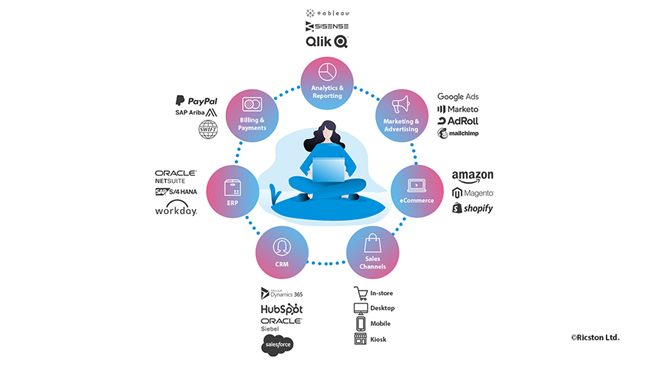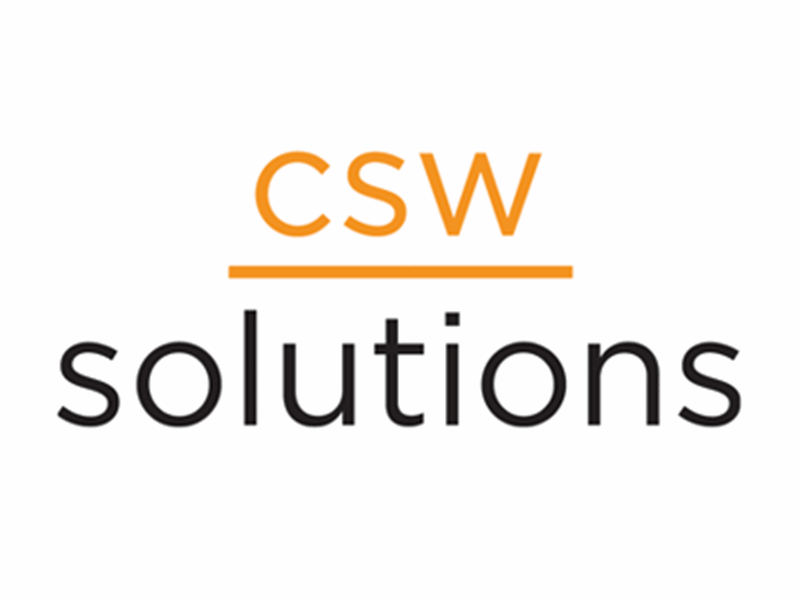For more information on your charming neighborhood CSW Solutions, visit us at our home or subscribe to our newsletter! We also do that social networking thing at: Twitter, Facebook, Linkedin, and Instagram! Check out our #funfactfridays
An Introduction to Systems Integration for eCommerce
eCommerce has become a booming industry in the wake of a global lock-down amidst a year-long pandemic. Quarantine, travel bans, and unprecedented closures forced the entire consumer market online. The world’s largest retailers soon followed and some industries even started selling direct to consumer (DTC) for the first time ever! That isn’t it say that business-to-business (B2B) has also experienced its own shift in growth. However, not all businesses had the infrastructure in place to deliver a world-class customer experience. That means some have not been able to successfully tap into the 24% increase in online sales last year. While there is a wealth of innovation to consider when it comes to the logistics of scaling and managing shifts in resources, it can be extremely challenging to see through the clutter. It is possible to do it all, from raising capital to marketing, fulfillment, customer service, and even staffing. But with growth comes responsibility and the space is getting… complicated.

Trends have turned toward specializing in new aspects of brand marketing and global awareness. One way DTC brands are standing out is through sustainable shipping and unique, personalized fulfillment. Humanizing your brand also aids in customer retention, now a top priority as acquisition costs rise and pivot in the wake of influencers and unconventional avenues like podcasts, subscription-based services, and AI. The unboxing video phenomenon has not only led to YouTube stars but it has also caused boutique and even bigger brands to invest in custom-branded packaging or limited-edition styling for the subscription-model fulfillment. Bigger retailers have also opted for automated replacement over the hassle of returns and customer service. Headless and API-driven eCommerce development allows continued innovation.
This all seems like a lot to consider and it truly is, as they say, ‘just the tip of the iceberg.’ Not only are more and more brands are competing for the same eyes but each business has its own moving parts. That is because every organization has essentially become an IT business and whether it will remain this way is hard to tell; with a plenitude of SaaS, mobile, IoT, and other technologies already implemented, even traditional industries have adapted a digital strategy. The new business model is based around IT and the cloud.
Regardless of the industry, enterprises end up owning a great number of systems: either built internally or acquired from third parties; cloud-based or on-premise. When asked to rank their top challenges, IT decision-makers put customer behavior in their top three; followed by legacy infrastructure and new systems integration, and security. Furthermore, there are concerns about expectations, redundancy, and budget constraints. Even from the top, the challenges ring familiar to anyone when it comes to integration.
When choosing a new system, one of the obvious criteria is the improvement to your particular business acumen in order to better manage operations and promote growth. No one has time to consider whether this system will fit within an existing digital landscape across the entire enterprise. However eventually, when the necessity for access and communication emerge, IT teams across departments have to find a way to make their apps start “talking” to one another, and system integration becomes necessary. This also requires something scalable so you can consistently use all your channels intelligently to make the most of your online presence or brand without worrying about how to maintain and run it from the ground up. But knowing how integration methods can work for your business and how they will manage your data is only half the battle. This post will go over the types of integration available and how they manage your workload.

Systems integration is basically the process of connecting the physical and digital IT infrastructure; inventory, databases, applications, protocols, formats, and data use patterns, into a centralized network. Each department likely has its own software to keep things in order and that means you’re probably using more software than you thought. Integrating these would not only keep you sane but also provide a consistent level of monitoring and data acquisition to improve awareness of not only consumer behavior but also areas of redundancy and promote less waste. Imagine your company data, budget, and operations compiled into one simple solution with a singular point of feedback!
Some of the different areas of your business that use their own particular software on a daily basis could be your human resources, accounting, and customer relationship management. Moving from web app to web app just seems normal these days but it certainly isn’t the most secure or practical way to manage your important data and make use of your infrastructure.
Methods of Systems Integration
There are countless software integration methods available for eCommerce technologies. In this guide, we will focus on the four main software integration methods you can use. They are API, ISC, Webhooks, and Orchestration. Each method has its benefits, so it is important to evaluate them accordingly so you know the right one for you.
The API Method
API-led connectivity gives users ease of use and flexibility by providing already available code within the product that enables most data variations. This method could mean a smoother transition in operations since it is the most widely used form of integration. Great examples of online APIs used in the eCommerce space would be Quickbooks or FreeAgent.
The drawbacks of this method are their code-intensive accessibility and dependency on supplier access. The software supplier is in control, so only they get to choose which platforms or apps can be integrated with their API. Therefore, what you can and can't do is very much dictated by who your software supplier decides to partner with. However, many companies offer an option to request integrations with additional web platforms.
It isn't a guarantee that you'll get your wish, but it may work out in your favor! Eventually, the integration can be coded for you but that leads to the second drawback. Nine times out of ten, API integrations come together seamlessly but, if you do happen to work on a platform that isn't partnered with the API you're looking to add, it can involve some full-time coding. It's always best to do your research when integrating systems.
The ISC Method
Integration Service Components (ISC) differ from APIs because they are not code-based integrations. ISCs live on a cloud-based server and connect to your local management tools from there. The benefits of choosing the ISC method are in the cloud. As long as your business has cloud-access to data, the ISC platform can integrate.
The cons to this method are twofold. First, you need someone on-board with database knowledge and second is that users need back-end access to their applications in order to integrate ISC components. It's rare that businesses have this type of access, especially in eCommerce.
The Webhooks Method
Webhooks can link software applications together without being code-based but code can draw information from the resulting communication. This is considered an "event-based" integration method and typically powered by third-party software. Some examples of Webhooks providers are Podio (with Globiflow), Zapier, and Zoho. These three options can be used for various facets of your business and can be used for a variety of business sectors. Integrating in this way can be powerful as it provides businesses with real-time data updates and more automation since the integration is event-based. But for the same reason, it means you are limited in how and when your data is pulled because it relies on an event occurring to update its data. Occasionally, this third-party software may "misfire" and not process an event you thought should be processed.
APIs can be more reliable in this regard because they aren't reliant on an event to alter data. The API allows users to update, or create, data without causing the software to activate.
The Orchestration Method
Orchestration works by eliminating repeated processes to increase production and workflow. This allows for more complete and seamless automation than other integrator. The data sharing is more streamlined and can boost your company to a new level of organizational transparency. In addition, orchestration allows users to manage several systems simultaneously.
While you can have one software integration system that fits all the pieces of the puzzle, it does come with some drawbacks. A system that is all-encompassing in this way can be very labor-intensive and code-intensive. Tasks, scheduling, and the number of systems to integrate must be considered in order to implement orchestration as a type of system integration. Because of its complex nature, orchestration typically requires more time and more staff to be executed well and then managed.
Orchestration vs Automation
The discussion of software integration often involves the term, "automation." Since it can be used somewhat haphazardly, it's important to distinguish between orchestration and automation. Both are worthy goals but differ slightly in what they accomplish.
Automation applies to assigned tasks ordered within a system. Automation will increase efficiency, and has an even bigger impact as your business scales and grows. A whole workflow is applied and the process becomes automated. An easy automation example would be the entire checkout process for an online shop.
Orchestration comes into play when you start to link your business from system to system. It's the overall automation of many tasks that make up an entire IT process. It can be challenging to take on, as it requires the knowledge of every necessary step within the process. It also typically takes place across various environments (i.e. web app, eCommerce store, mobile devices, databases, etc.). Although it may seem daunting, orchestration may be worth the effort if you're running a larger eCommerce platform because of its proficiency with data analytics. Inventory can be assessed and stocked based on usage patterns and performance can be analyzed for further efficiency.

Bringing It All Together
The many different types of integration available mean there really is something for everyone. All it takes is to look at your business and figure out exactly what your needs are by determining what you want out of your integration so you can focus on growth and opportunity. Essentially, we all want intelligent automation with the right mix of AI and ROI and the right configuration of systems integration can bring all of that together.
For more information on systems integration and all the other ways you can leverage the Azure cloud, check out the rest of our blog articles or subscribe to our monthly newsletter! CSW Solutions is a Cloud Service Provider and a Microsoft Gold-certified partner. As always, feel free to contact us with any questions. We love hearing from our readers.
